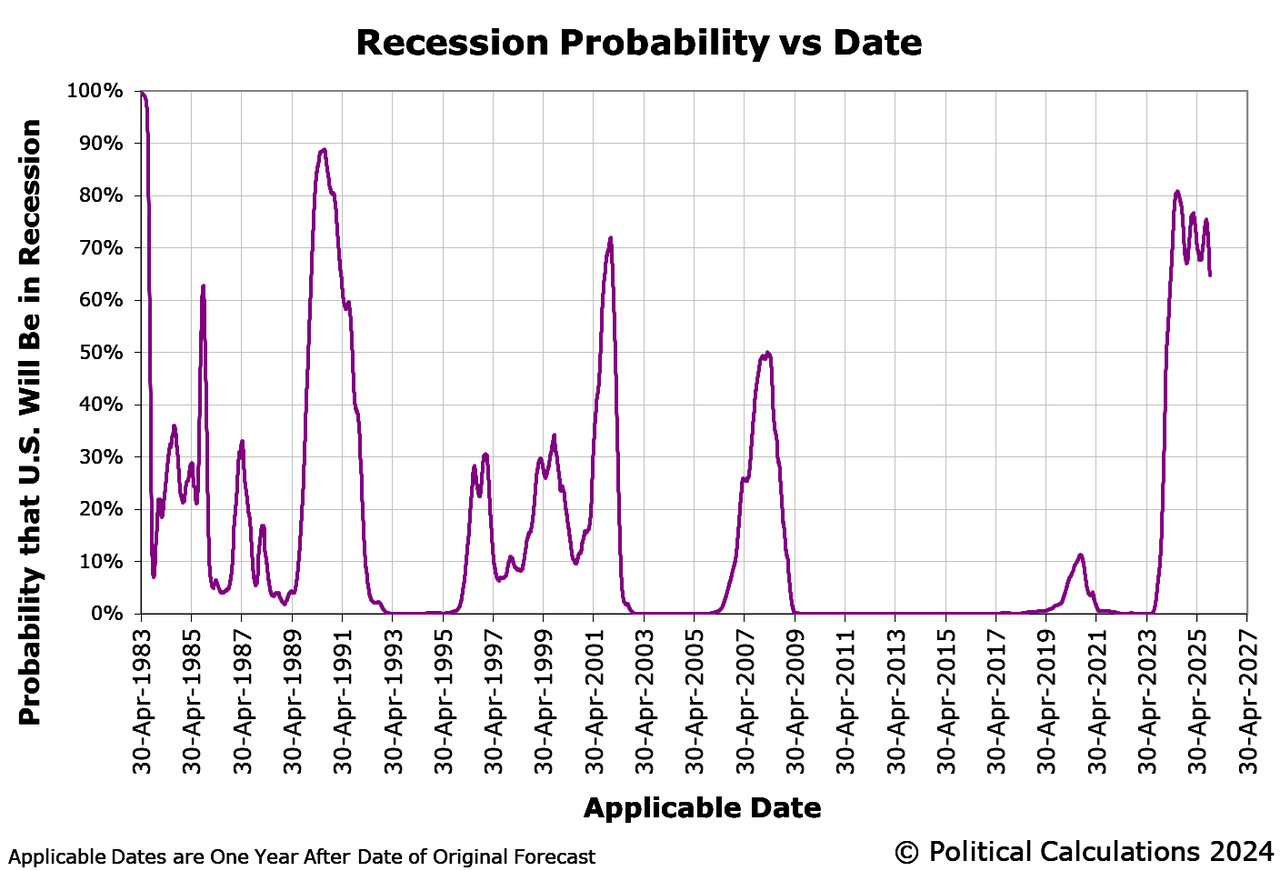Summary
- The probability of recession is now rapidly falling. The downward direction is likely to continue as the Federal Reserve is expected to deliver a quarter-point reduction in the Federal Funds Rate at the conclusion of its Federal Open Market Committee meetings on 7 November 2024.
- The current probability of a recession being officially determined to have begun between 1 November 2024 and 1 November 2025 is 64.8%.
- The recession probability presented here is based on the Federal Reserve Board’s yield curve-based recession forecasting model.

MCCAIG
As expected, the probability of a U.S. economic recession began to diminish rapidly after the Federal Reserve implemented a half-point rate cut at its mid-September 2024 meetings.
The change follows the recession odds setting a “triple-top” pattern, in which the probability of recession peaked for the third time after breaching a 70% threshold. The probability of recession is now rapidly falling.
That downward direction is likely to continue as the Federal Reserve is expected to deliver a quarter-point reduction in the Federal Funds Rate at the conclusion of its Federal Open Market Committee meetings on Thursday, 7 November 2024. Those meetings start on 6 November 2024, which is why we’re providing this update at this time. We’re showing a portion of the analysis Fed officials have available as they weigh how to set the level of the Federal Funds Rate.
In the following chart tracking the probability of recession since 30 April 1983, the period from July 2024 through September 2025 represents the most likely period in which the NBER will say the U.S. economy peaked before beginning a period of contraction. And even though the probability of recession someday being found to have started sometime in the next twelve months is now falling, those odds remain elevated.
The current probability of a recession being officially determined to have begun between 1 November 2024 and 1 November 2025 is 64.8%. The featured chart shows that probability ‘pushed out’ to the end of the period for which the recession forecast applies.
Analyst’s Notes
The recession probability presented here is based on the Federal Reserve Board’s yield curve-based recession forecasting model, which factors in the one-quarter average spread between the 10-year and 3-month constant maturity U.S. Treasuries and the corresponding one-quarter average level of the Federal Funds Rate. If you’d like to do that math using the latest data available to anticipate where the Recession Probability Track is heading, we have provided a tool to make it easy to do.
We will continue following the Federal Reserve’s Open Market Committee’s meeting schedule in providing updates for the Recession Probability Track until the U.S. Treasury yield curve is no longer inverted and the future recession odds retreat below a 20% threshold. We’re following how this forecasting method performs.
Ironman is the alias of the blogger at Political Calculations, a site that develops, applies and presents both established and cutting edge theory to the topics of investing, business and economics. We should acknowledge that Ironman is either formerly or currently, and quite possibly, simultaneously employed as some kind of engineer, researcher, analyst, rocket scientist, editor and perhaps as a teacher of some kind or another. The scary thing is that’s not even close to being a full list of Ironman’s professions and we should potentially acknowledge that Ironman may or may not be one person. We’ll leave it to our readers to sort out which Ironman might behind any of the posts that do appear here or comments that appear elsewhere on the web!
Shared by Golden State Mint on GoldenStateMint.com


















